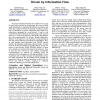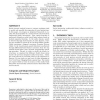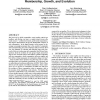267 search results - page 16 / 54 » On the approximability of influence in social networks |
KDD
2006
ACM
14 years 9 months ago
2006
ACM
Statistics on networks have become vital to the study of relational data drawn from areas such as bibliometrics, fraud detection, bioinformatics, and the Internet. Calculating man...
ATAL
2009
Springer
14 years 3 months ago
2009
Springer
To better represent human interactions in social networks, the authors take a network-oriented simulation approach to analyze the evolution of acquaintance networks based on local...
SIGIR
2006
ACM
14 years 2 months ago
2006
ACM
We propose that the information access behavior of a group of people can be modeled as an information flow issue, in which people intentionally or unintentionally influence and in...
ICMI
2010
Springer
13 years 6 months ago
2010
Springer
Social network analysis became a common technique used to model and quantify the properties of social interactions. In this paper, we propose an integrated framework to explore th...
KDD
2006
ACM
14 years 9 months ago
2006
ACM
The processes by which communities come together, attract new members, and develop over time is a central research issue in the social sciences -- political movements, professiona...



